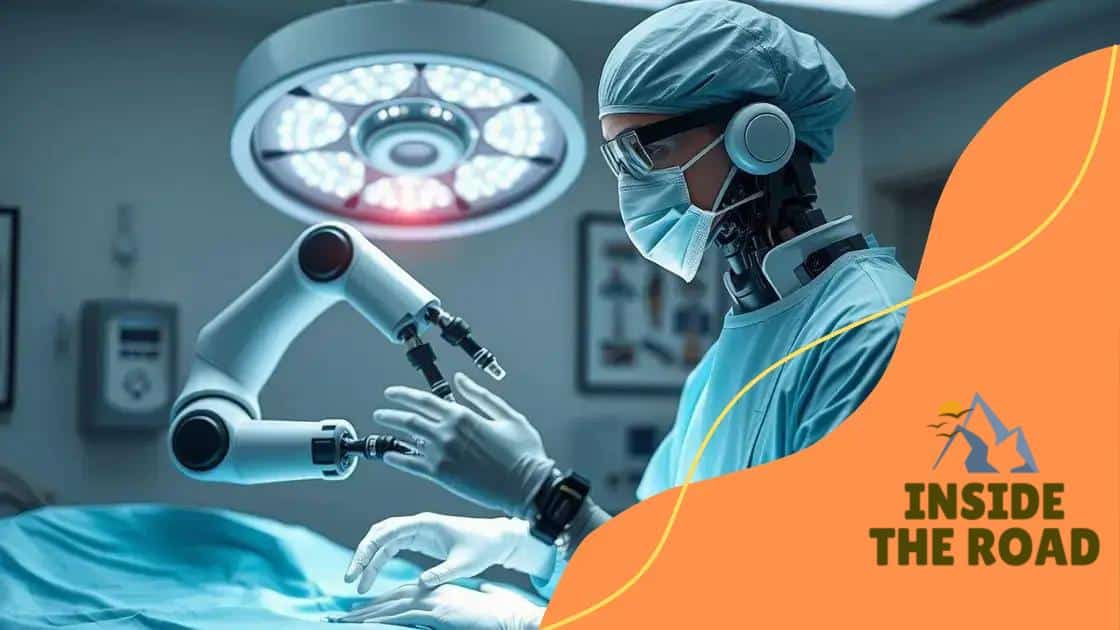How 5G networks are improving healthcare delivery

How 5G networks are improving healthcare delivery by enhancing telemedicine, enabling real-time patient monitoring, and facilitating personalized medicine while addressing challenges like infrastructure upgrades and data security.
How 5G networks are improving healthcare delivery is a fascinating topic that sheds light on advancements in patient care. With faster connections and innovative technologies, there’s so much potential to explore.
Understanding 5G technology in healthcare
Understanding 5G technology in healthcare is essential to grasping how it revolutionizes patient care. As the fifth generation of mobile networks, 5G offers unprecedented speed and connectivity. It allows healthcare professionals to communicate more effectively and share data instantaneously.
Key Features of 5G
One major aspect of 5G technology is its low latency, which is crucial for real-time applications. This minimizes delays in communication, ensuring that critical information gets to the right person promptly. Additionally, the enhanced bandwidth available with 5G enables more devices to connect simultaneously without any drop in performance.
- High-speed data transfer
- Support for Internet of Medical Things (IoMT)
- Enhanced remote diagnostics
- Improved telemedicine capabilities
With the support of IoMT, healthcare devices can communicate continuously, providing doctors with real-time health information about their patients. This connectivity opens doors to advanced treatments and faster responses during emergencies.
Challenges and Solutions
However, implementing 5G technology in healthcare isn’t without challenges. Some facilities may need to upgrade their infrastructure. Security concerns also arise, as connected devices can be vulnerable to hacking. Addressing these issues requires careful planning, training for staff, and investments in technology.
Nevertheless, the potential benefits of 5G far outweigh the challenges. As more hospitals and clinics invest in this technology, we can expect improved patient outcomes and more efficient healthcare delivery.
Key benefits of 5G for medical services
The key benefits of 5G for medical services are transforming the way healthcare is delivered. With its advanced capabilities, 5G enhances communication and improves patient outcomes significantly. Fast data transfer and reliable connectivity create an environment where healthcare providers can operate more efficiently.
Improved Telemedicine
One of the most impactful advantages of 5G is the enhancement of telemedicine. This technology allows doctors to connect with patients remotely in real time. Patients can receive care without needing to visit the hospital, which is especially valuable during emergencies.
- Instantaneous video consultations
- Reduced wait times for patients
- Access to specialists regardless of location
- Increased patient satisfaction
Another significant benefit is the ability to monitor patients using connected devices. These devices can send data continuously, helping doctors detect issues before they become critical.
Enhanced Data Management
With the support of 5G technology, healthcare facilities can manage vast amounts of data more effectively. Hospitals can share patient records and images quickly and securely. This seamless exchange of information leads to better diagnosis and treatment plans.
Additionally, real-time data sharing can improve research capabilities, allowing healthcare professionals to analyze trends and track the spread of diseases promptly. This ability to act quickly can potentially save lives.
Moreover, 5G enables healthcare facilities to implement advanced technologies such as augmented reality for training surgeons or educating staff. These innovations pave the way for more effective training methods and better patient care.
Real-world applications of 5G in hospitals

Real-world applications of 5G in hospitals are revolutionizing healthcare delivery. With its incredible speed and low latency, 5G enables a variety of services that improve patient care and operational efficiency.
Remote Surgery
One of the most groundbreaking applications is remote surgery. Surgeons can operate on patients from miles away using robotic tools. This is possible because 5G allows for real-time video feeds and instant feedback for precision.
- High-definition video for optimal visibility
- Quick response times crucial during procedures
- Expanded access to surgical expertise
- Minimized travel for both patient and surgeon
This technology saves time and resources while enabling complex surgeries to be performed even in remote locations.
Real-Time Patient Monitoring
Another significant application is real-time patient monitoring. Smart devices can gather and transmit health data continuously, allowing healthcare providers to respond rapidly to changes in a patient’s condition. This is especially useful in critical care and emergency situations.
Devices connected through 5G can monitor everything from heart rates to oxygen levels, keeping clinicians informed at all times. This technology can lead to faster interventions and better patient outcomes.
The implementation of 5G also enhances the management of hospital resources. With connected equipment, hospitals can track usage and performance in real time. This helps optimize workflows and reduce waste.
As hospitals continue to adopt 5G technology, we can expect even more innovative applications that further improve healthcare delivery.
Challenges in implementing 5G in healthcare
Challenges in implementing 5G in healthcare can hinder its full potential. While the benefits are numerous, various obstacles must be addressed to ensure smooth integration into existing systems.
Infrastructure Upgrades
The first challenge is the need for significant infrastructure upgrades. Many hospitals currently rely on older technologies that may not support 5G. This means costly investments in new hardware and software are necessary.
- Upgrading networking equipment
- Ensuring compatibility with existing systems
- Installing new 5G antennas
- Maintaining current services during upgrades
Without these updates, healthcare facilities may struggle to utilize the full capabilities of 5G technology.
Data Security Concerns
Another critical concern is data security. With more devices connected through 5G, the risk of data breaches increases. Sensitive patient information could be exposed if robust cybersecurity measures are not in place.
Healthcare providers must invest in security solutions to protect patient data. This includes firewalls, encryption, and access controls. Additionally, employee training on data security practices is essential to minimize risks.
Regulatory compliance is also a significant factor. Healthcare organizations must ensure that their 5G systems comply with HIPAA and other regulations, which can add complexity to the implementation process.
Lastly, staff training and adaptation to new technologies can be a hurdle. Healthcare workers need to be trained in using 5G enabled devices and systems effectively. This requires time and resources, which can be challenging to manage in busy healthcare environments.
Future prospects of 5G in patient care
The future prospects of 5G in patient care are very promising. As technology continues to advance, 5G is set to reshape how healthcare services are delivered. With its enhanced capabilities, we can anticipate a range of exciting developments.
Personalized Medicine
One area poised for growth is personalized medicine. With 5G, healthcare providers can analyze genetic data more efficiently. This allows for tailored treatment plans that are specifically designed for individual patients.
- Faster data analysis leading to quicker decisions
- More accurate predictions about treatment outcomes
- Improved patient engagement through better communication
- Access to real-time data about patient responses
This level of personalization will enhance the effectiveness of treatments and lead to higher patient satisfaction.
Advanced Remote Monitoring
Another significant prospect is advanced remote monitoring. 5G technology enables the seamless transfer of health data from wearable devices. Patients can be monitored in real time, which can be life-saving in critical situations.
These devices can track various health metrics, such as heart rate, glucose levels, and activity. With constant monitoring, healthcare providers can detect problems early and intervene quickly when necessary.
Furthermore, the integration of artificial intelligence (AI) with 5G will allow for predictive analytics in patient care. AI can analyze vast amounts of data, helping to foresee potential health issues before they arise. This proactive approach will change how healthcare systems operate, improving overall outcomes.
The collaboration between technology companies and healthcare institutions will also contribute to innovations in 5G applications. As partnerships grow, we will likely see new tools and solutions emerge that enhance patient care across the board.
FAQ – Questions about 5G Technology in Healthcare
What are the main benefits of 5G in healthcare?
The main benefits include enhanced telemedicine, real-time patient monitoring, and personalized medicine, all of which improve patient care and outcomes.
What challenges are faced when implementing 5G in hospitals?
Challenges include the need for infrastructure upgrades, data security concerns, and employee training for new technologies.
How does 5G improve telemedicine?
5G allows for faster and more reliable video consultations, which enhances remote communication between patients and healthcare providers.
Can 5G technology help in emergency situations?
Yes, with real-time data transmission, healthcare providers can monitor urgent patient conditions and respond more swiftly during emergencies.






